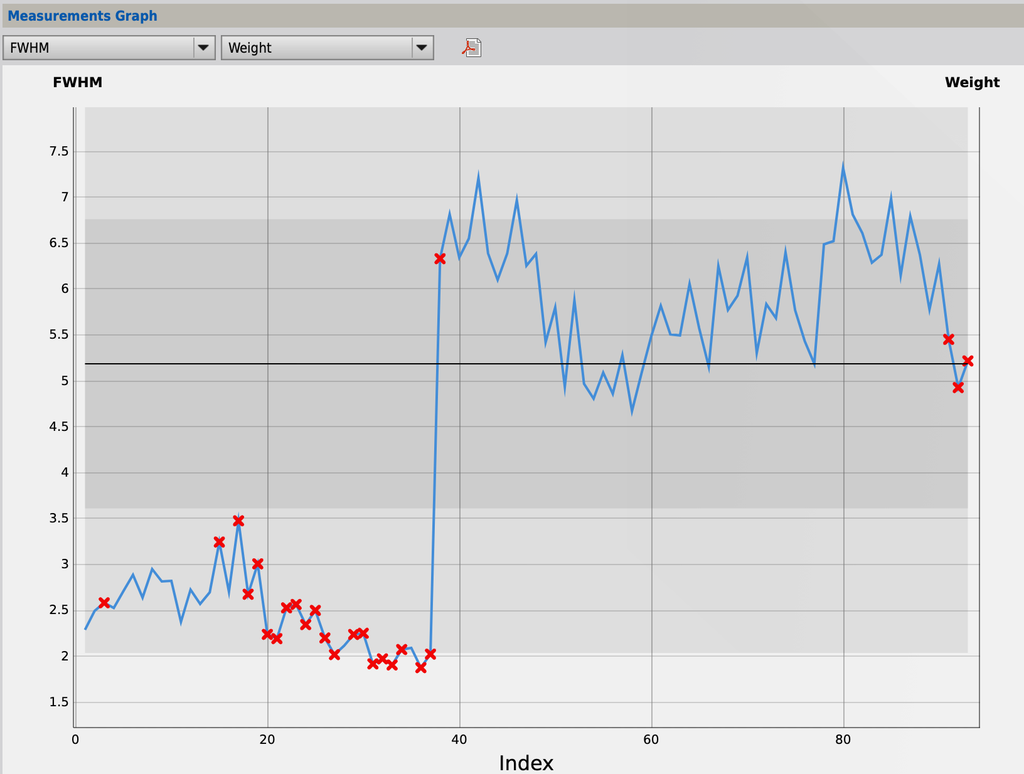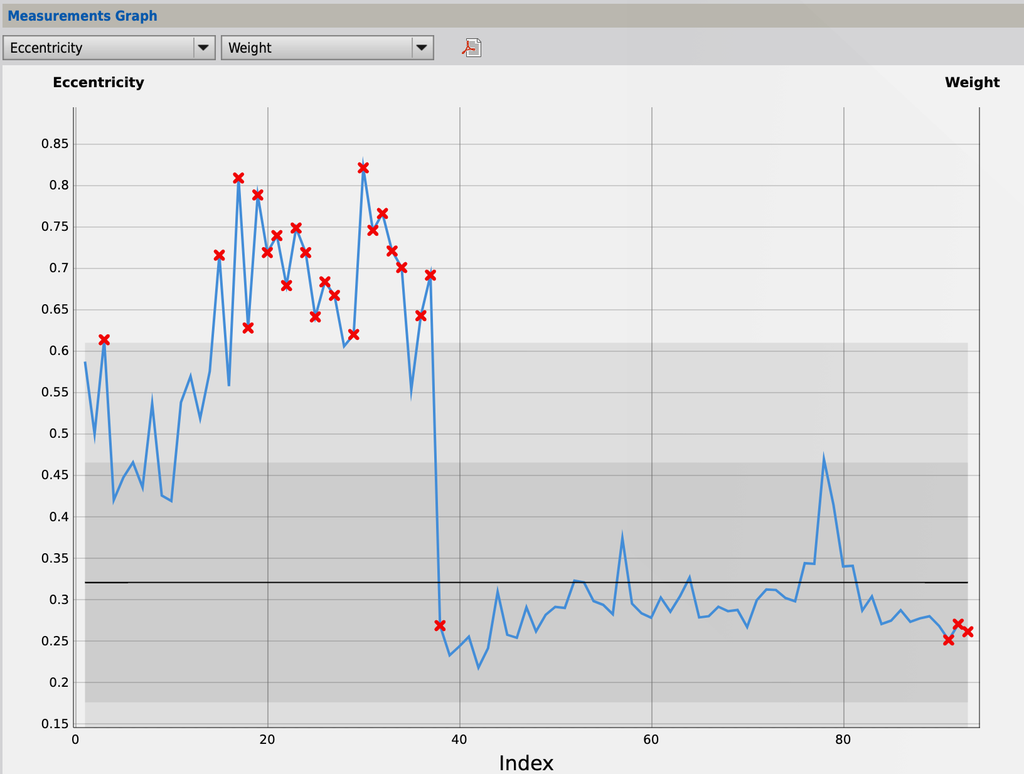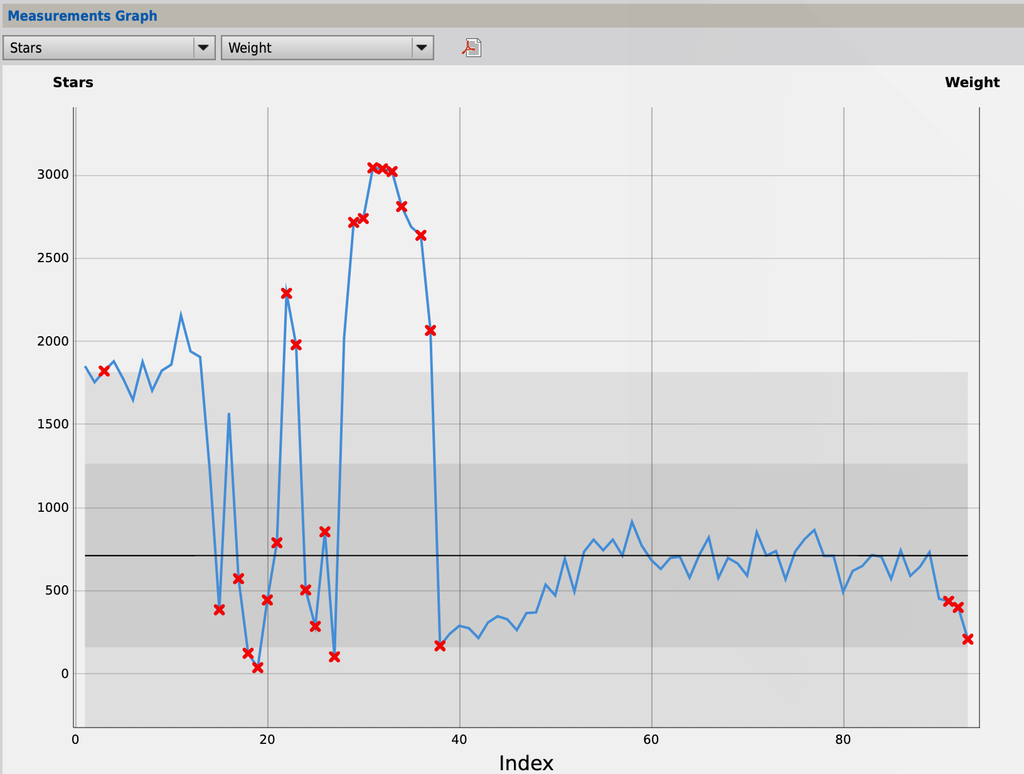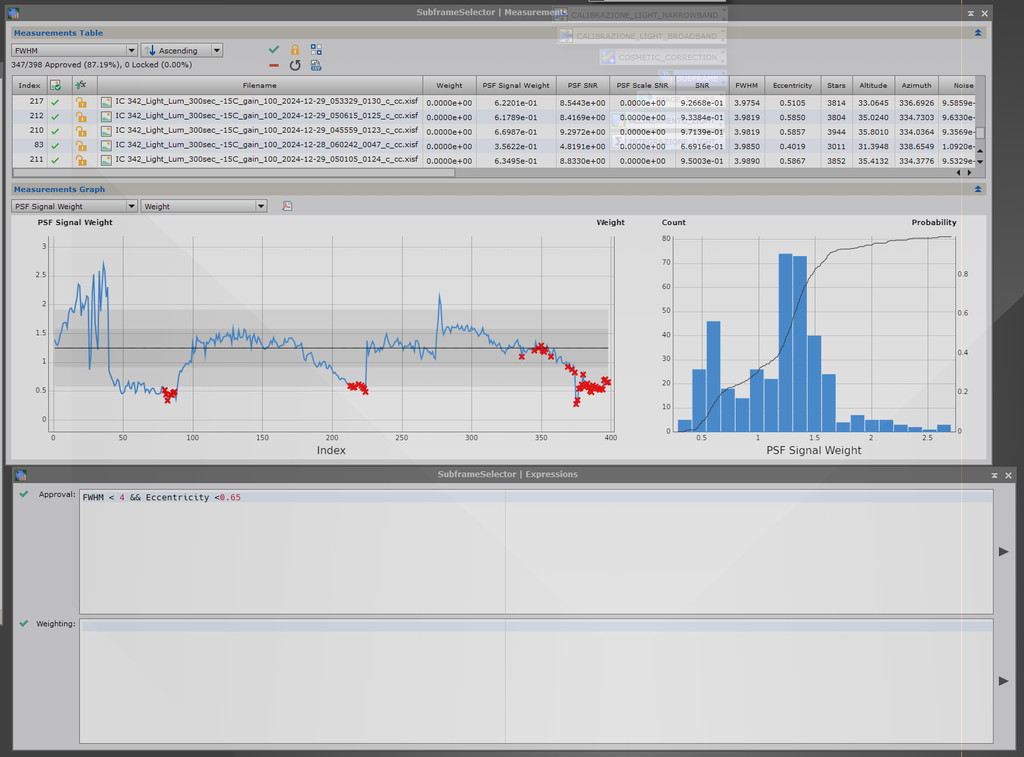I had a really good night of imaging the Statue of Liberty but the following night was not as good. I use PI's Subframe Selector with the below settings to filter out the good from the bad. As the Subframe Selector calculates an average over the whole series, adding more bad frames would worsen the standard deviations. I am now wondering what would improve detail/SNR to the master light or if it just get worse. Specifically with the two different nights of frames below (first night better FWHM, second night better eccentricity). Curious for some thoughts on this, for example would you only use the best of the first night, overall best, or calculate the best separately, .... Thanks! Subframe Selector approval settings:FWHMSigma <= 2 &&EccentricitySigma <=2 &&MedianSigma <=2 &&StarsSigma >= -1.5 FWHM, eccentricity and star count for the clear night are the first 37 frames, second night from frame 38 onwards (though this should be clear on the difference 🤣)    |
You cannot like this item. Reason: "ANONYMOUS".
You cannot remove your like from this item.
Editing a post is only allowed within 24 hours after creating it.
You cannot Like this post because the topic is closed.
Copy the URL below to share a direct link to this post.
This post cannot be edited using the classic forums editor.
To edit this post, please enable the "New forums experience" in your settings.
Add them separately and average them; if the final SNR is better and details don't suffer (too much) keep otherwise reject.
|
You cannot like this item. Reason: "ANONYMOUS".
You cannot remove your like from this item.
Editing a post is only allowed within 24 hours after creating it.
You cannot Like this post because the topic is closed.
Copy the URL below to share a direct link to this post.
This post cannot be edited using the classic forums editor.
To edit this post, please enable the "New forums experience" in your settings.
I did not read the posts you have received already, but here my personal approach:
In the SFS, I always look at three topics - FWHM, Eccentricity and Stars. Stars give me an idea about the clarity of the sky - the more stars, the clearer it was. Eccentricity tells me how good my guiding/polar alignment was - some deviations, you can correct perfectly with the BXT module, but I do normally limit my tolerance to the light grey area above the zero line. FWHM tells me, how good my focussing plus seeing was - same procedure, light grey shaded area for standard targets, and dark grey for very subtle and small, delicate targets.
My approach might be right or wrong, well, that is clear, but that is how I do it normally. Exceptions do exist of course…
CS
Georg
|
You cannot like this item. Reason: "ANONYMOUS".
You cannot remove your like from this item.
Editing a post is only allowed within 24 hours after creating it.
You cannot Like this post because the topic is closed.
Copy the URL below to share a direct link to this post.
This post cannot be edited using the classic forums editor.
To edit this post, please enable the "New forums experience" in your settings.
Georg N. Nyman:
I did not read the posts you have received already, but here my personal approach:
In the SFS, I always look at three topics - FWHM, Eccentricity and Stars. Stars give me an idea about the clarity of the sky - the more stars, the clearer it was. Eccentricity tells me how good my guiding/polar alignment was - some deviations, you can correct perfectly with the BXT module, but I do normally limit my tolerance to the light grey area above the zero line. FWHM tells me, how good my focussing plus seeing was - same procedure, light grey shaded area for standard targets, and dark grey for very subtle and small, delicate targets.
My approach might be right or wrong, well, that is clear, but that is how I do it normally. Exceptions do exist of course...
CS
Georg this is the same approch that i do!
|
You cannot like this item. Reason: "ANONYMOUS".
You cannot remove your like from this item.
Editing a post is only allowed within 24 hours after creating it.
You cannot Like this post because the topic is closed.
Copy the URL below to share a direct link to this post.
This post cannot be edited using the classic forums editor.
To edit this post, please enable the "New forums experience" in your settings.
andrea tasselli:
Add them separately and average them; if the final SNR is better and details don't suffer (too much) keep otherwise reject. You mean to stack the two days separately, average them post-stacking, and check for SNR improvement?
|
You cannot like this item. Reason: "ANONYMOUS".
You cannot remove your like from this item.
Editing a post is only allowed within 24 hours after creating it.
You cannot Like this post because the topic is closed.
Copy the URL below to share a direct link to this post.
This post cannot be edited using the classic forums editor.
To edit this post, please enable the "New forums experience" in your settings.
Georg N. Nyman:
I did not read the posts you have received already, but here my personal approach:
In the SFS, I always look at three topics - FWHM, Eccentricity and Stars. Stars give me an idea about the clarity of the sky - the more stars, the clearer it was. Eccentricity tells me how good my guiding/polar alignment was - some deviations, you can correct perfectly with the BXT module, but I do normally limit my tolerance to the light grey area above the zero line. FWHM tells me, how good my focussing plus seeing was - same procedure, light grey shaded area for standard targets, and dark grey for very subtle and small, delicate targets.
My approach might be right or wrong, well, that is clear, but that is how I do it normally. Exceptions do exist of course...
CS
Georg That is the process I normally do as well. My question was how you select the frames that you perform the SFS calculations on? Given that adding more “less good” frames to your SFS selection makes the standard deviation (grey bars) get larger, which results in more frames are selected that otherwise would not have been. And this versus a smaller selection with smaller standard deviation… Now that I’m typing, I think @andrea tasselli answered my question 😂
|
You cannot like this item. Reason: "ANONYMOUS".
You cannot remove your like from this item.
Editing a post is only allowed within 24 hours after creating it.
You cannot Like this post because the topic is closed.
Copy the URL below to share a direct link to this post.
This post cannot be edited using the classic forums editor.
To edit this post, please enable the "New forums experience" in your settings.
You mean to stack the two days separately, average them post-stacking, and check for SNR improvement? Yes
|
You cannot like this item. Reason: "ANONYMOUS".
You cannot remove your like from this item.
Editing a post is only allowed within 24 hours after creating it.
You cannot Like this post because the topic is closed.
Copy the URL below to share a direct link to this post.
This post cannot be edited using the classic forums editor.
To edit this post, please enable the "New forums experience" in your settings.
Hi this is my approach: first insert SUB scale and camera gain 2- in approval mode ( depending on condition of subframe) i reject some subframe with value greater than...X, then i remove this subframe with the red line because otherwise they would be calculated in the weighting formula   subsequently I analyze the various values of fwhm and eccentricity and stars. I do not use SNR anymore because it detects completely wrong values and often indicates a terrible image as a good image. the values below the median (gray line I take little into consideration)
|
You cannot like this item. Reason: "ANONYMOUS".
You cannot remove your like from this item.
Editing a post is only allowed within 24 hours after creating it.
You cannot Like this post because the topic is closed.
Copy the URL below to share a direct link to this post.
This post cannot be edited using the classic forums editor.
To edit this post, please enable the "New forums experience" in your settings.
this is my formula on weighting  my considerations are: a beautiful eccentricity does not mean that the fwhm value is beautiful (maybe it is the worst). for this reason on the galaxies I put a greater weight on FWHM. instead of using SNR, you should use STARS OR flux BECAUSE they give a global idea of the frames in which there are more stars and where the stars are more point-like and precise. if the partial weight between fwhm and eccentricity is similar, the final fact +40 is almost useless (I did some practical tests)
|
You cannot like this item. Reason: "ANONYMOUS".
You cannot remove your like from this item.
Editing a post is only allowed within 24 hours after creating it.
You cannot Like this post because the topic is closed.
Copy the URL below to share a direct link to this post.
This post cannot be edited using the classic forums editor.
To edit this post, please enable the "New forums experience" in your settings.
Unfortunately in your case you seem to have tracking/guiding issues. When the FWHM is higher the eccentricity is generally acceptable (below 0.4) however when the seeing gets better and the images are sharper the seeing blur no longer hides the tracking issues and the eccentricity suffers. Before spending any more time trying to decide how to best cull images I suggest working on the guiding issue, which will then allow you to be much more likely to get to keep the images you capture with good seeing.
|
You cannot like this item. Reason: "ANONYMOUS".
You cannot remove your like from this item.
Editing a post is only allowed within 24 hours after creating it.
You cannot Like this post because the topic is closed.
Copy the URL below to share a direct link to this post.
This post cannot be edited using the classic forums editor.
To edit this post, please enable the "New forums experience" in your settings.
Why do people even use SubFrameSelector today? Doesn't the new weighting schemes in PixInsight just take care of it all? (Especially PSF Signal Weight)? Can't you just go change the number in WBPP Integration Tab / Minimum Weight to reject frames some percentage less than the best frame?
What's the harm in stacking all the frames, good and bad, as long as they are properly weighted?
|
You cannot like this item. Reason: "ANONYMOUS".
You cannot remove your like from this item.
Editing a post is only allowed within 24 hours after creating it.
You cannot Like this post because the topic is closed.
Copy the URL below to share a direct link to this post.
This post cannot be edited using the classic forums editor.
To edit this post, please enable the "New forums experience" in your settings.
SubFrameSelector doesn't do any culling at all, it just assesses parameters. It's they, the end users, that assign a weight according to a variety of parameters and it is still they that might do the culling. if they fancy so. I do cull. And I have my own formula for the weights.
|
You cannot like this item. Reason: "ANONYMOUS".
You cannot remove your like from this item.
Editing a post is only allowed within 24 hours after creating it.
You cannot Like this post because the topic is closed.
Copy the URL below to share a direct link to this post.
This post cannot be edited using the classic forums editor.
To edit this post, please enable the "New forums experience" in your settings.
My personal approach: I just blink and manually reject anything that isnt round enough or where the seeing is atrocious and stars are bloated. I use everything else. To go through an entire night of data takes me maybe 3 minutes…. about as fast as I can hit the down arrow key. Most frames I reject are impacted by clouds anyway. IMO people get way too hung up on culling data. I'm just here to make a pretty picture. With tools like BlurX in the wild now, there is far less incentive for me to be hyper critical of subframes like I used to be. When I image from home in Vermont, it's the lack of clear nights thats the real problem. Not seeing, or anything else… unless you consider seeing as whether or not you can see the stars.  Put another way, the prettiness of the pictures I make, are far less impacted by the subframes and more-so by my limitations with processing data. YMMV Have fun,
|
You cannot like this item. Reason: "ANONYMOUS".
You cannot remove your like from this item.
Editing a post is only allowed within 24 hours after creating it.
You cannot Like this post because the topic is closed.
Copy the URL below to share a direct link to this post.
This post cannot be edited using the classic forums editor.
To edit this post, please enable the "New forums experience" in your settings.
Chris White- Overcast Observatory:
My personal approach: I just blink and manually reject anything that isnt round enough or where the seeing is atrocious and stars are bloated. I use everything else. To go through an entire night of data takes me maybe 3 minutes.... about as fast as I can hit the down arrow key. Most frames I reject are impacted by clouds anyway.
IMO people get way too hung up on culling data. I'm just here to make a pretty picture. With tools like BlurX in the wild now, there is far less incentive for me to be hyper critical of subframes like I used to be. When I image from home in Vermont, it's the lack of clear nights thats the real problem. Not seeing, or anything else... unless you consider seeing as whether or not you can see the stars. 
Put another way, the prettiness of the pictures I make, are far less impacted by the subframes and more-so by my limitations with processing data. YMMV
Have fun, It all depends on what you're trying to achieve and the plate scale. For my CDK images at 0.31 arcsec/pixel I'm extremely picky about culling and will only use excellent, low FWHM data (it all has excellent eccentricity because I'm lucky enough to have an excellent mount), when the seeing was the best. I do this because for those targets I'm specifically trying to achieve an extremely detailed, high resolution result. For my refractor images I only cull obviously bad frames like things with clouds or some giant plane multi-trail (satellite trails are fine) because at 0.89 arcsec/pixel and a much wider FOV I'm not really focusing on resolution so much as I am other things where I'm prioritizing high SNR over high detail.
|
You cannot like this item. Reason: "ANONYMOUS".
You cannot remove your like from this item.
Editing a post is only allowed within 24 hours after creating it.
You cannot Like this post because the topic is closed.
Copy the URL below to share a direct link to this post.
This post cannot be edited using the classic forums editor.
To edit this post, please enable the "New forums experience" in your settings.
I typically have the expression look at three things:
1) FWHM
2) Eccentricity
3) Number of stars
Typically eccentricity should be at or below .5 but if there are very few stars that number can be higher since few stars tends to skew things. Look at the images that are greater than .5 to decide where to set it if you decide to go large than .5
FWHM depends on the scope and the seeing and the target detail and the filter. Some objects may have little detail in some bands so eliminating higher FWHM for those subs is less critical. The same is true for RGB vs Lum since Lum is where the detail needs to be.
Number of stars is a good way to weed out subs where there may have been high clouds or poor transparency. Note that the moon being up also results in fewer stars.
I would not use sigma at all, just absolute values. You should have a feel for what your site and system can produce and set accordingly.
|
You cannot like this item. Reason: "ANONYMOUS".
You cannot remove your like from this item.
Editing a post is only allowed within 24 hours after creating it.
You cannot Like this post because the topic is closed.
Copy the URL below to share a direct link to this post.
This post cannot be edited using the classic forums editor.
To edit this post, please enable the "New forums experience" in your settings.








